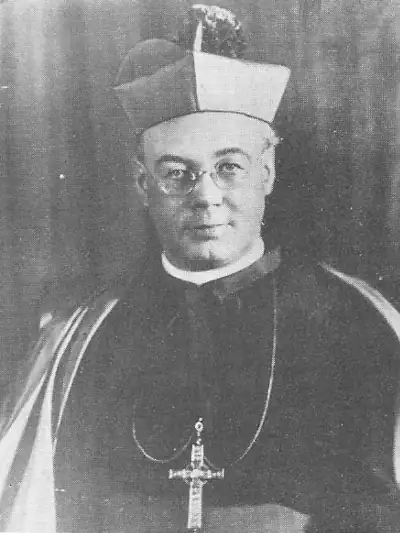Rev. Francis X. Gilfillan
Biography

Early Life and Education
Francis X. Gilfillan was born on 16 February 1872 in the townland of Aghavas, Carrigallen parish, County Leitrim, Ireland. He was the son of Thomas Gilfillan and Brigid Curran. Gilfillan received his early schooling at the National School in Corduff and at Moyne Classical School (Dromard, near Arva). He then studied for the priesthood at St. Patrick’s College, Carlow. In 1894 he left Ireland to complete his ecclesiastical studies in the United States, enrolling at the Catholic University of America in Washington, D.C. There he was a distinguished student and earned a Doctor of Divinity (cum maxima laude). Gilfillan was ordained a priest for the Archdiocese of St. Louis by Archbishop John J. Kain on June 24, 1895.
Ministry in St. Louis
After ordination, Gilfillan served in the Archdiocese of St. Louis. He began as a curate at the Cathedral parish of St. Louis and in 1907 was named pastor of the Cathedral Parish. During this period he also took on diocesan responsibilities: he served on the board of Kenrick Seminary in St. Louis and on the archdiocesan board of synodal examiners. Notably, Gilfillan helped oversee the construction of the Cathedral Basilica of St. Louis. A contemporary account observes that “for some years he worked in the Diocese of St. Louis where he took a leading part in the building of the new Cathedral in that city”. In other words, as rector of the parish Gilfillan played a key role in realizing Archbishop Kain’s vision (and later Archbishop Glennon’s) for the new cathedral structure in St. Louis.
Episcopacy in Missouri
On July 8, 1922, Pope Pius XI appointed Gilfillan Titular Bishop of Spigas and Coadjutor Bishop of St. Joseph, Missouri, with the right to succeed the incumbent Bishop Maurice F. Burke. He was consecrated a bishop on November 8, 1922. Following Bishop Burke’s death on March 17, 1923, Gilfillan automatically became the third Bishop of St. Joseph. In this role he continued to emphasize education and social welfare. Gilfillan chose to live simply among his priests rather than in a separate episcopal palace. He “preferred to live with his priests” in the cathedral rectory. During his decade as bishop he founded or completed several institutions: most notably, “his interest in the welfare of children led to the opening of the old Tootle home … as an orphanage, and to the construction of Christian Brothers High School” in St. Joseph. (The “old Tootle home” became St. Joseph’s boys’ orphanage, and the school he built later became Bishop LeBlond High School.) Bishop Gilfillan died suddenly of heart disease at the cathedral rectory on January 13, 1933, at age 60.
Historical Scholarship and Legacy
Throughout his life Gilfillan maintained a deep interest in the history of his native Leitrim and in Irish heritage. He was elected a life member of the Breifny (Cavan-Leitrim) Antiquarian Society, reflecting his engagement with local scholarship. The Society’s obituary praised that his “brilliant intellect shed lustre on the County of his birth”. Contemporaries note that Fr. Gilfillan authored several historical pamphlets on Leitrim topics – for example, studies of the 1650 Synod held at Jamestown, Co. Leitrim, on the history of County Leitrim, and on O’Sullivan Beare (likely referring to Philip O’Sullivan Beare, the 17th-century Gaelic historian and exile, whose writings chronicled the Irish Catholic struggle during the Elizabethan and early Stuart periods). These booklets circulated among local historical circles, underscoring his scholarly side even as a diocesan prelate.
Family and Final Years
Gilfillan came from a notably religious family. In Ireland, his brother Rev. Thomas J. Gilfillan ministered in the Diocese of Kilmore and later Ardagh. Two of his sisters, Sister Patricia and Sister Joseph, joined the Sisters of Mercy in Manorhamilton. Many of his other relatives are recorded as priests in Ireland. In Missouri he became a well-known figure – remembered for his affable character, devotion to education and children, and his modest lifestyle. His obituary in 1933 was widely carried in Catholic papers, noting that under his leadership “the cause of Catholic education” prospered in both St. Louis and St. Joseph. He was buried in St. Joseph, and later successors (such as Bishop Charles H. LeBlond) continued to build on his legacy of schools and welfare projects. To this day Gilfillan is remembered in diocesan histories and in County Leitrim as a son who devoted himself both to the Church in America and to the history and welfare of his native land.
Works
- Pamphlet on the 1650 Synod held at Jamestown, Co. Leitrim
- Pamphlet on the history of County Leitrim
- Pamphlet on Philip O’Sullivan Beare
References
- Bishop Gilfillan of St. Joseph, Mo., Dies. (1933, January 28). The Bulletin of the Catholic Laymen’s Association of Georgia, p. 1.
- Cheney, D. M. (n.d.). Bishop Francis Gilfillan. Catholic Hierarchy. https://www.catholic-hierarchy.org/bishop/bgilfi.html
- Francis Gilfillan. (2024, August 28). In Wikipedia. https://en.wikipedia.org/wiki/Francis_Gilfillan
- Obituary. (1934). Breiffne Antiquarian and Historical Society Journal 1931-1933, III(3), 438.
- Parish History. Cathedral St. Joseph. (n.d.). https://cathedralsj.org/about/parish-history
